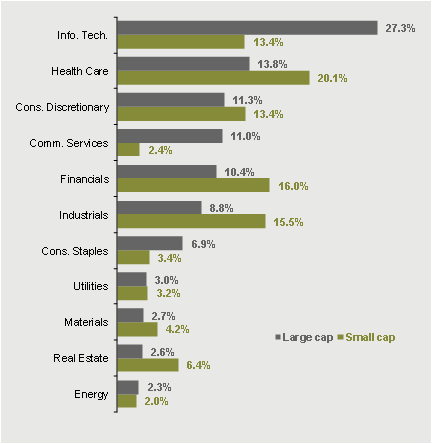Written by: David Lebovitz
"For investors that can stomach potential risks, small cap stocks may offer opportunities for meaningful upside, particularly as the economic recovery strengthens in 2021."
The likelihood of a divided government in 2021, coupled with positive news on vaccine development, has ignited animal spirits. After trailing large caps for the better part of the year, small caps have outperformed so far in the fourth quarter; this dynamic has coincided with value stocks outperforming growth stocks, which makes sense given that both small caps and value stocks tend to be more cyclical than their large cap and growth counterparts. But what can these vaccines tell us about the opportunity in small caps going forward?
Historically, the financial sector has been the largest weight in the small cap benchmark, making an investment in small caps effectively a play on regional banks. This dynamic led to a tight relationship between interest rates and small cap performance, as regional banks tend to rely on plain vanilla lending – and therefore, net interest margins – to drive earnings and revenues. Earlier this year, however, health care overtook financials as the largest weight in the small cap index. Small cap health care companies are primarily biotech firms with very volatile streams of earnings, but 2020 has given us empirical evidence of the value that these types of companies can create.
The global economy and population have been battling COVID-19 for the better part of this year, but recent vaccine announcements are finally providing some sense of when we might return to normal. The two most promising vaccines at the current juncture leverage relatively new technology, rather than taking the traditional approach of injecting a weakened or dead virus. This newer approach introduces an mRNA sequence (the molecule which tells cells what to build) that is coded for a disease specific antigen – in this case, the RNA contains the sequence for the COVID-19 spike protein, which once inside the cell, triggers an immune response. In other words, these vaccines contain a blueprint that allows the body to identify the proteins on the surface of COVID-19 and destroy the virus if it enters the body.
Developing new technologies, particularly when it comes to medicine, requires taking risks. This explains why a decent share of the biotech names in the small cap universe have negative earnings – they are developing products that may or may not work as intended, and sometimes, these projects fail. Given this potential for big wins or big losses, these investments are volatile, but can also pay off over time. For investors that can stomach these potential risks, small cap stocks may offer an opportunity for meaningful upside, particularly as the economic recovery strengthens in 2021.
Health care is now the largest part of the small cap index
% of index market capitalization

Related: How Can I Use Alternatives for Income and Diversification?

